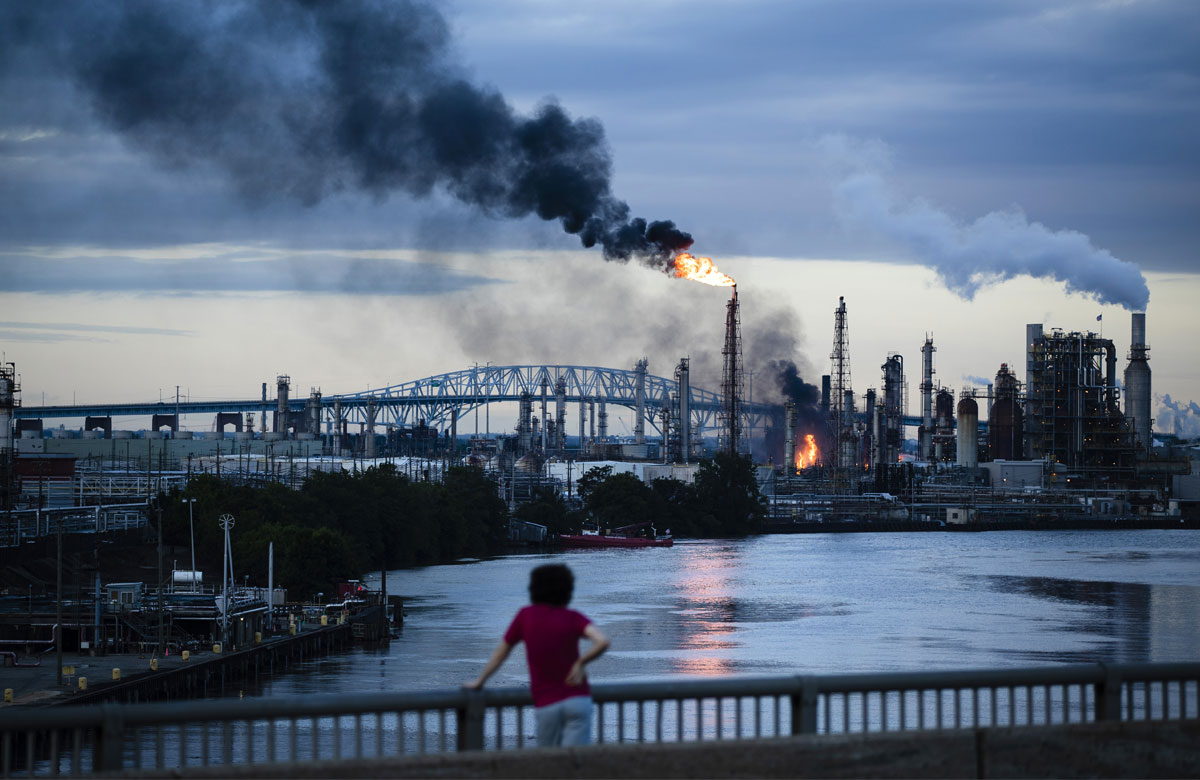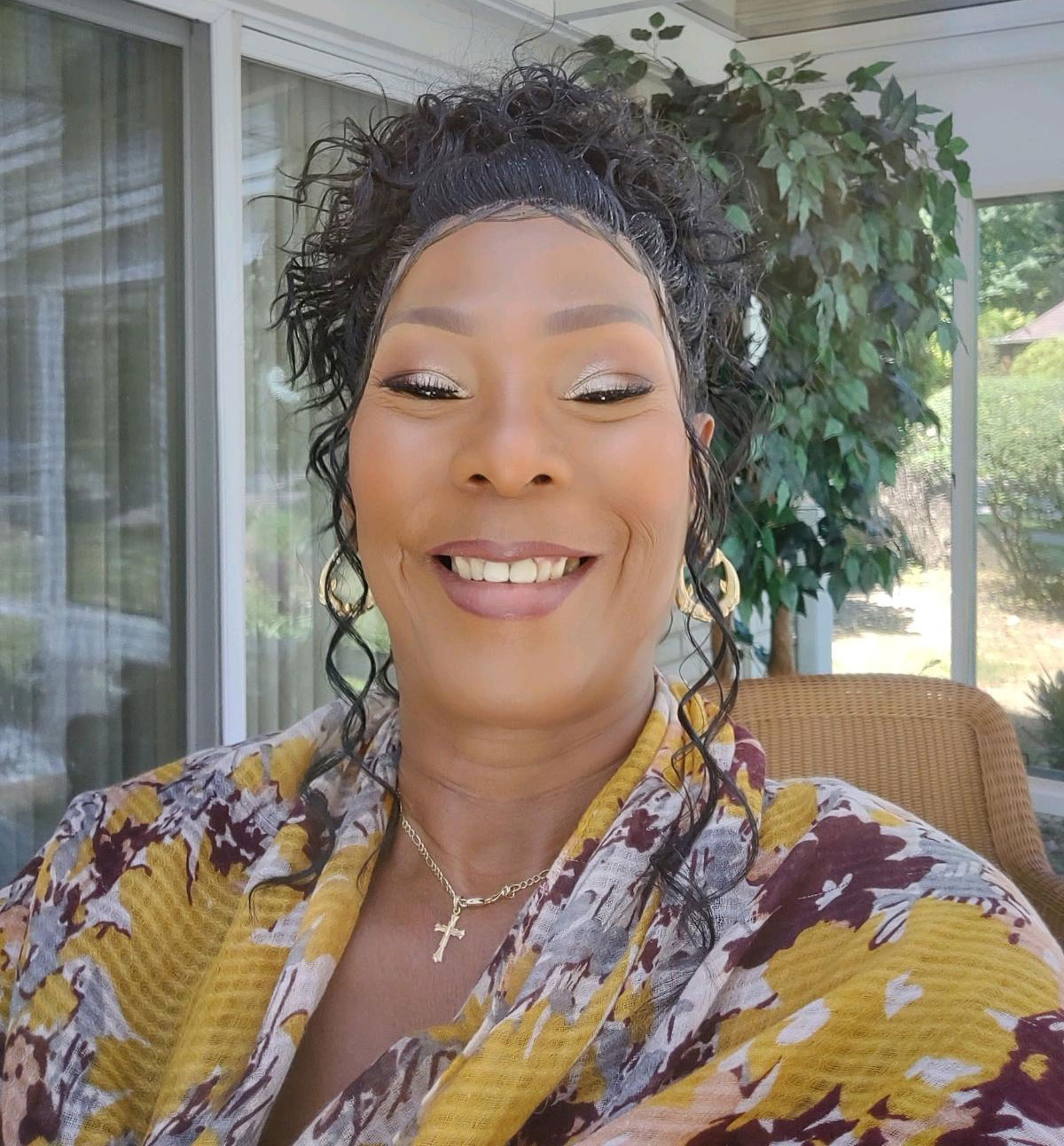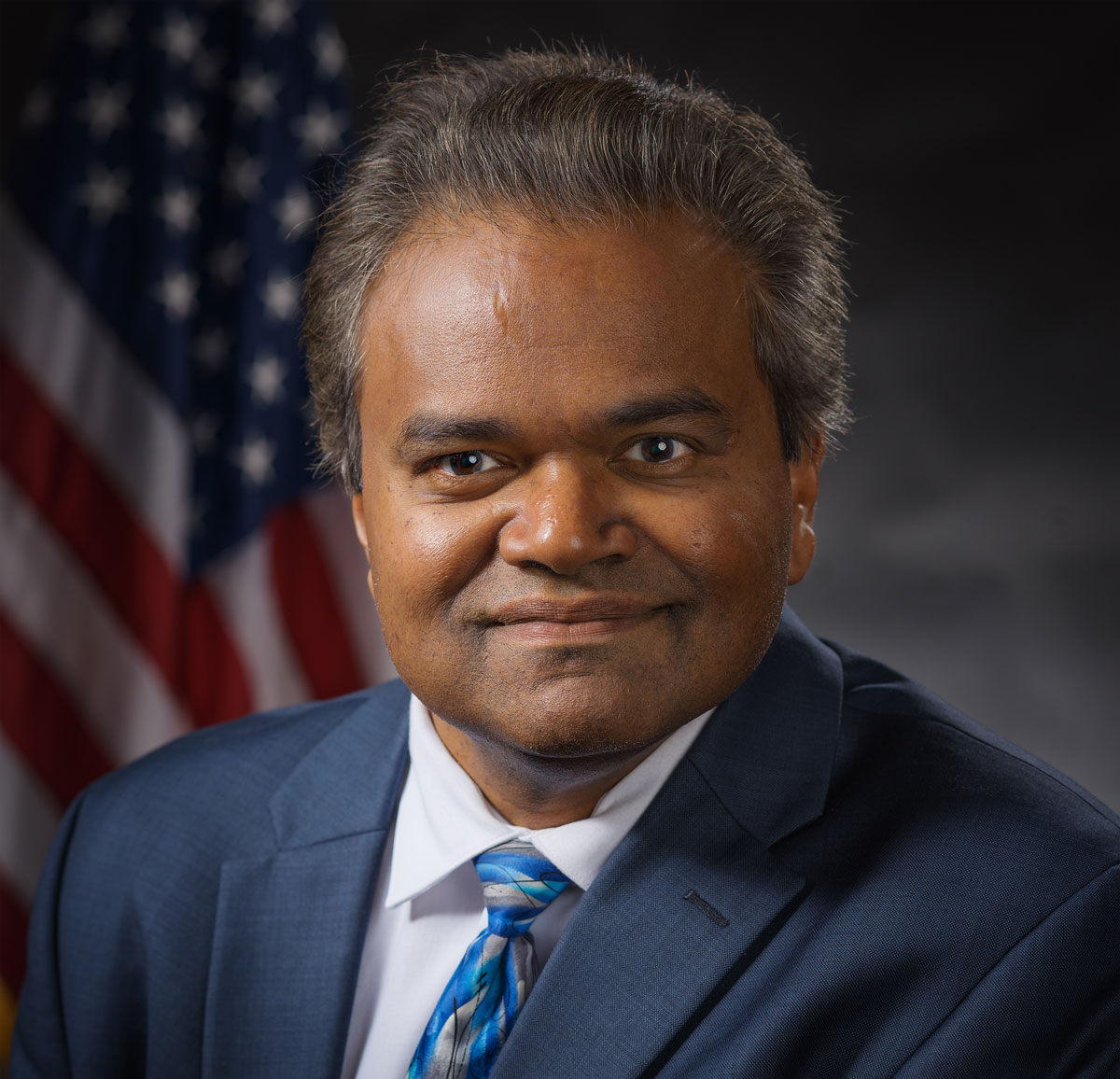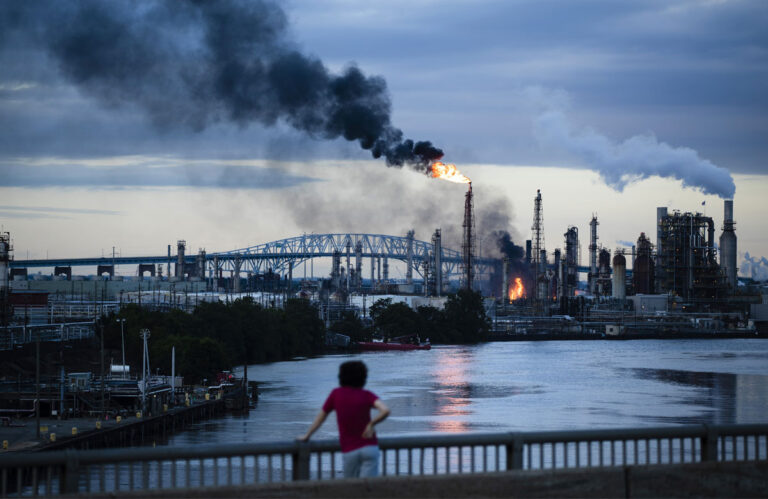
Photo courtesy of Matt Rourke/Associated Press
Flames and smoke engulfed the Philadelphia Energy Solutions Refining Complex on June 21, 2019, after a series of explosions shook homes and caused extensive damage at the refinery. The company later shuttered the 150-year-old site.
Carol White was sleeping on the third floor of her house when she felt the explosions. Windows shattered and buildings shook across her South Philadelphia neighborhood as neighbors fled into the street. By the time she opened her front door, ash was falling like rain.

“How do you become a survivor, if you’re not able to find the source of it all?”
— Carol White
She had never had asthma in the past, but suddenly she found it hard to breathe. Sitting in her home moments later, she felt an intense pressure in her chest. She jumped in her car, chased by ash still drifting through the air, and raced to the hospital.
Four years since her neighborhood woke to the early-morning blasts that destroyed the Philadelphia Energy Solutions (PES) oil refinery, the largest and oldest on the East Coast, the 63-year-old still takes multiple asthma medications to deal with her own personal fallout. Her tears now feel like glass unless she uses prescription eye drops.
The multiple explosions that rocked South and Southwest Philadelphia on June 21, 2019, released more than 3,000 pounds of deadly hydrogen fluoride into the atmosphere, along with more than 600,000 pounds of hydrocarbons. PES was forced to declare bankruptcy and sell the acreage for redevelopment. But for years before a corroded pipe doomed the facility, neighboring communities had been calling for its closure and an investigation of its damaging health effects. After watching so many friends and family grow sick in the refinery’s shadows, White calls the surrounding blocks “cancer alley.”
Jane Clougherty still recalls her first impression of the air quality when she moved to the nearby Grays Ferry neighborhood in 2016 to join the faculty of Drexel’s Dana and David Dornsife School of Public Health as a professor in the Department of Environmental and Occupational Health.
“I was shocked, stunned and appalled by what I smelled,” Clougherty says.
The neighborhoods near the refinery have for decades been beset on all sides by a combination of polluting sources that Clougherty describes as “a glaring environmental justice concern.” Rowhomes have been hemmed in by highways, situated north of an airport and west of a shipping port, with the refinery’s billowing exhaust a steady and unwanted companion.
“I’ve been worried about my own health and really amazed by how little monitoring was happening,” Clougherty says, “and how little scientific understanding we had of the very complex combination of pollution sources impacting that area.”
Now, as the cleanup and redevelopment of the refinery risk stirring up additional pollutants into the mix, Clougherty is embarking on research to reveal what’s at stake. Alongside Sheila Tripathy, senior research scientist at Dornsife School of Public Health, and in partnership with Philly Thrive, an environmental justice advocacy group that includes White and many of her neighbors, Clougherty is conducting monitoring that will finally give community members trustworthy data about the air they breathe.
Their work will receive support from the Environmental Collaboratory, an initiative launched by Drexel last year to apply community-centered solutions to environmental problems. Clougherty and Tripathy’s research is one of the Collaboratory’s seven inaugural projects that aim to meaningfully improve the quality of life for communities coping with environmental threats.
A Study in South Philadelphia
Tripathy recalls being shocked by the size of the PES refinery complex when she came to Philadelphia to work with Clougherty as a postdoc fellow in 2017. Driving over the Girard Point Bridge on the way to the Philadelphia International Airport, she marveled at how many people lived within the wind currents that gusted over the refinery’s flare stacks.
She eventually became acquainted with the organizers of Philly Thrive, who were working to have the complex shut down. At the time, the refinery was fully operational, and a survey found that 34% of the community members had asthma, more than four times the national average. Heart disease, cancer and other respiratory diseases were rampant.
Even two years after the 2019 explosion, when demolition and cleanup were already underway, the 1,300-acre South Philadelphia facility was still the country’s second-worst emitter of benzene, a carcinogen often found alongside other dangerous volatile organic compounds. Though nonoperational, the plant emitted benzene at double the EPA’s “action level.”
For Tripathy, understanding what White and her neighbors had been through gave her research with Clougherty depth and meaning.
“I met people who lived in the area and heard their stories, heard them talk about their lives and how their families have lived there for generations,” says Tripathy. “Seeing that side of it made me feel it was important that someone do more monitoring of the area, so people know what’s happening and can use the data to advocate for more monitoring, more studies, and to have government agencies come in and do something.”
Tripathy and Clougherty’s research, which has funding from the National Institutes of Health in addition to the Collaboratory, will place nearly two dozen thermal desorption tubes on telephone poles in the neighborhoods surrounding the refinery. The tubes contain charcoal filters that will passively collect volatile organic compounds, or VOCs, in the air.
After a week, the air samples will be retrieved and shipped to a Lewis-Clark State College chemist named Nancy Johnston for analysis. Johnston worked on similar research as part of FIREX-AQ, a joint venture between the National Oceanic and Atmospheric Association and NASA that studied how wildfires affect air quality. That research led her to Drexel chemist Ezra Wood, associate professor and chair of the Chemistry Graduate Program Committee, who connected her with Clougherty. Johnston had the ability to measure very low-concentration VOCs with high precision.
The researchers will also use separate instruments to monitor fine particulate matter that will be chemically analyzed by the Wisconsin State Laboratory of Hygiene. The matter is composed of miniscule airborne particles, created by combustion, that can enter the bloodstream and wreak respiratory and cardiovascular havoc.
Their samples will reveal for the first time the variety of pollutants emitted, their patterns across the neighborhood and how pollution concentrations vary over time. By law, the Environmental Protection Agency requires companies to monitor benzene and related VOCs around the fenceline of a refinery, and this has provided communities around the country with a modicum of data about the air they breathe over the years. But the data is severely limited because it measures air quality only around the perimeter of the facility itself and is averaged over two-week periods. In Philadelphia, it has never been provided to community members in a format that they could reliably access and interpret.
With the help of Lisa Frueh, a Dornsife doctoral student in environmental and occupational health, and Karlin Moore, a Dornsife master’s student in biostatistics, the research team will rotate the testing units throughout the affected neighborhoods every week to understand how pollution varies across space and time. They will be able to identify where specific metals within the fine particulate matter — such as manganese or lead — may raise particular concern, and how changes in wind patterns affect air quality over the course of the year. Members of Philly Thrive are eager to assist with the field work.
The ultimate goal is to make these findings accessible to ordinary citizens.
“If we can translate reports into something that’s legible for the people making the decisions,” Frueh says, “we can play a supporting role, helping to amplify community concerns that are already there.”
After years of searching for the truth from the EPA and the two corporate entities sharing responsibility for remediation of the site — Evergreen Resources Group and Hilco Redevelopment Partners — the people of South Philadelphia will have information they can trust and act upon.
“We are an unbiased third party,” says Clougherty. “We’ve taken the time to make sure they understand and are comfortable with our methods. So if we tell them concentrations have gone down, that can provide relief to them.”
A Raft of Research
The Environmental Collaboratory’s mission is to bring researchers and community members together to tackle environmental challenges. That means that every research project it funds must address a climate-related or environmental justice problem identified by community members themselves — and co-led by a community-based organization.
Initial funding for the Collaboratory came from a $2 million, two-year grant from the Waverly Street Foundation. Further funding will come from project-based federal grants — it has already received a small prize from the Department of Energy — and co-funding with community-based organizations, with the eventual goal being an endowment.
All parties involved in Collaboratory projects are expected to take an historical, holistic, human view of environmental issues that examines why problems exist and who they harm.
“If you want to partner with us, everything you do has to be centered in justice and equity and the history of systemic racism,” says Mathy Stanislaus, vice provost and executive director of the Collaboratory (see story below, “Seeker of Solutions”). “Whether you’re a biologist or an engineer, it’s not a blank slate. There’s a history of disparities and disinvestments. You have to take the community as it is, not how you would want it to be.”
The Collaboratory is also pursuing funding for a separate effort that will focus on protecting people and places from climate change’s impact on flooding and extreme weather through the use of early-warning systems and emergency preparedness and response. The work will be done in consultation with the most vulnerable communities and water utilities in the region.
It is also laying the groundwork for a bipartisan group that will work to advance climate solutions locally, sharing best practices and conducting workshops for government officials who want to implement climate-centered projects such as clean energy or infrastructure adaptations. At every step, Stanislaus wants the Collaboratory to be part of “on-the-ground solution building” that brings along all stakeholders necessary for implementation.
The Collaboratory’s community-driven approach is “an excellent model” for how to make research meaningful and effective, says Johnston of Lewis-Clark State College: “They’re the stakeholders. They’re the people affected by the environmental conditions — the air, the water, the soil, their surroundings.”
“Our Grandchildren’s Future’’
When Carol White’s mother died of cancer two years ago, Carol couldn’t help but wonder if the refinery had something to do with it: She’d been living near the refinery for more than 25 years; her mother had visited so many times, every weekend for years…each breath pulling in poison. Now Carol worries about her grandchildren.
In Philly Thrive, White has found a way to push back against the entities responsible for the pollutants that have harmed her family and friends. And in the Collaboratory’s research, she and her neighbors can gain the detailed data, and the means to interpret it, that they need to change their circumstances.
“If we as a community don’t come together and fight these people, it’s doomed to happen again,” White says. “We’re fighting more than one devil here. How do you become a survivor if you’re not able to find the source of it all? Our children and grandchildren won’t have a future, unless we do something now.”
SEEKER OF SOLUTIONS
The Environmental Collaboratory’s inaugural executive director, Vice Provost Mathy Stanislaus, was working on a chemical engineering degree at the City College of New York when two events changed his life’s trajectory.
When civil war broke out in his native Sri Lanka, Stanislaus poured himself into refugee assistance. He helped with asylum petitions and enlisted Congressional support on his countrymen’s behalf. Everyone he encountered seemed to be a lawyer.
Around the same time, in December 1984, a disaster at a pesticide plant in Bhopal, India, exposed over 500,000 people to methyl isocyanate, a toxic chemical, killing as many as 20,000 people. Watching it all unfold from afar, he decided to pursue a law degree that would link his concerns for human rights and the environment with his chemical engineering studies.

“If you want to partner with us, everything you do has to be centered in justice and equity and the history of systemic racism. There is a history of disparities and disinvestments. You have to take the community as it is, not how you would want it to be.”
— Mathy Stanislaus, Executive Director of the Collaboratory
He spent years fighting for environmental justice and community empowerment, serving on the board of the community-driven New York City Environmental Justice Alliance and co-founding a New York-based organization that helped redevelop brownfields, then served two terms in the Obama administration in the EPA’s Office of Land and Emergency Management.
He put community needs at the center of every issue he oversaw: brownfields, Superfund sites, recycling, natural disaster and emergency response.
After the 2010 Deepwater Horizon oil spill in the Gulf of Mexico, he spent months in Louisiana learning about local residents’ needs and finding ways to keep them informed.
Most recently, he worked at the World Economic Forum — a global consortium of large companies, governments, civic leaders and academics — to address issues including child labor and the authentication of greenhouse gas emissions in the scale-up of electric vehicles and renewable energy.
“I’ve always approached my work in a human rights paradigm,” Stanislaus says. “Environmental practitioners approach it from an environmental practice perspective, and lawyers approach it from a transactional perspective. I view these as tools to enable a human rights-based solution.”
For a long time, he felt that academia stood in opposition to much of what he was pursuing. When Columbia University sought to expand into West Harlem in the mid-2000s, he fought the effort as a technical adviser to the local community board, worried about its impact on neighborhood residents in the form of displacement and gentrification.
“I’ve criticized academia for not respecting communities, not being in service of communities, not studying communities, and not respecting ownership of research products and for displacing communities,” Stanislaus says.
So, when he was asked to apply to lead the Collaboratory as executive director, he voiced his vision and his concerns over the course of five months of direct conversations with Drexel’s leadership to ensure the Collaboratory’s authenticity. “I didn’t want to join something that was not real,” he says.
Ultimately, he was convinced. He saw a genuine opportunity to scale the wall that stands between academia and the communities he cares so deeply about.
“At this moment of greenwashing and misinformation and disinformation, coupled with the disparities in communities, academia can play a really important role in trust- and solution-building,” Stanislaus says. “Traditional academic research needs to continue with assurances of community participation and ownership, but it needs to be complemented by translating and delivering information so community stakeholders can make decisions. Unless you do that, you are effectively taking the decision away from community-based organizations.”


